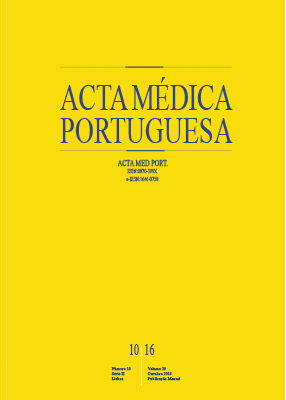Congenital Heart Disease in Children with Down Syndrome: What Has Changed in the Last Three Decades?
DOI:
https://doi.org/10.20344/amp.7318Keywords:
Cardiac Surgical Procedures, Down Syndrome, Heart Defects, Congenital, Treatment Outcome.Abstract
Introduction: The prevalence of Down syndrome has increased in the last 30 years; 55% of these children have congenital heart disease.
Material and Methods: A retrospective longitudinal cohort study; clinical data from 1982 to 2013 databases with the diagnosis of Down syndrome or trisomy 21 in a reference hospital in pediatric cardiology and cardiac surgery.
Objective: to assess the progress in the last three decades of cardiological care given to children with Down syndrome and congenital
heart disease.
Results: We studied 102 patients with Down syndrome and congenital heart disease subjected to invasive therapy: corrective or palliative cardiac surgery and therapeutic catheterization. The referral age was progressively earlier in patients referred in the first year of life. The most frequent diagnosis was complete atrioventricular sptal defect (41%). There was a trend towards increasingly early corrective surgery in patients under 12 months (p < 0.001). Since 2000, the large majority of patients were operated before reaching six months of age. The main cardiac complications were rhythm dysfunction and low output. More frequent noncardiac complications were pulmonary and infectious. The 30-day mortality rate was 3/102 cases (2.9%). Of patients in follow-up, 89% are in NYHA class I.
Discussion and Conclusion: The early surgical correction seen over the past 15 years follows the approach suggested in the literature. The observed 30-day mortality rate is overlapping international results. Patients with Down syndrome subjected to corrective surgery of congenital heart disease have an excellent long-term functional capacity.
Downloads
Downloads
Published
How to Cite
Issue
Section
License
All the articles published in the AMP are open access and comply with the requirements of funding agencies or academic institutions. The AMP is governed by the terms of the Creative Commons ‘Attribution – Non-Commercial Use - (CC-BY-NC)’ license, regarding the use by third parties.
It is the author’s responsibility to obtain approval for the reproduction of figures, tables, etc. from other publications.
Upon acceptance of an article for publication, the authors will be asked to complete the ICMJE “Copyright Liability and Copyright Sharing Statement “(http://www.actamedicaportuguesa.com/info/AMP-NormasPublicacao.pdf) and the “Declaration of Potential Conflicts of Interest” (http:// www.icmje.org/conflicts-of-interest). An e-mail will be sent to the corresponding author to acknowledge receipt of the manuscript.
After publication, the authors are authorised to make their articles available in repositories of their institutions of origin, as long as they always mention where they were published and according to the Creative Commons license.









